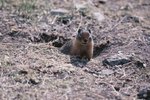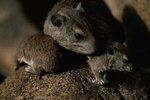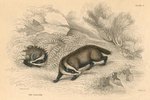
Rodents are important components of virtually all terrestrial ecosystems; rodents serve as food for a variety of predators, play important roles in seed dispersal and construct burrows that become homes for other animals as well. Several of the endangered wildlife species of Connecticut, including timber rattlesnakes and barn and long-eared owls, depend on these rodent species for survival.
Woodchucks
Woodchucks (Marmota monax) are medium-sized, solitary, ground-dwelling rodents that spend most of their time in underground tunnels. Woodchucks consume plants, flowers and fungi during the day, but sometimes woodchucks forage nocturnally as well. The woodchuck’s burrowing behavior provides a service to the habitat, increasing plant and microbe biodiversity by aerating the soil. Additionally, many animals, including snakes, rabbits and turtles, use abandoned woodchuck burrows for shelter.
Squirrels and Chipmunks
Gray squirrels (Sciurus carolinensis), red squirrels (Tamiasciurus hudsonicus) and flying squirrels (Glaucomys sabrinus) live throughout Connecticut, where they spend most of their times in trees, eating nuts, fruits, flowers and the occasional insect or bird egg. Red and gray squirrels are diurnal, while flying squirrels are nocturnal. The name “flying squirrel” is a misnomer -- flying squirrels are not capable of powered flight, instead using a membrane between their front and back legs to glide passively from tree to tree. Chipmunks are primarily terrestrial, though they will occasionally climb trees to collect food. Chipmunks use their large cheeks to carry nuts and food from their foraging grounds to their cache locations.
Beavers and Porcupines
The American beaver (Castor canadensis) and North American porcupine (Erethizon dorsatum) are the largest and second largest rodent, respectively, in Connecticut. Both have a similar diet, composed largely of the shoots, buds and the inner bark of trees. As large rodents that drew the attention of many predators, the ancestors of beavers and porcupines had to develop strong defense mechanisms to protect themselves. Porcupines defend themselves with their sharp quills while beavers build lodges and swim well to escape predators.
Rats, Mice, Voles and Lemmings
Many rat, mouse and vole species inhabit Connecticut. White-footed mice (Peromyscus leucopus), meadow voles (Microtus pennsylvanicus) and woodland voles (Microtus pinetorum) are three common species that inhabit a variety of habitats within the state’s borders. While most rodents have quick reproductive cycles, some voles have the most rapid reproductive cycle known in mammals; less than two months after a female meadow vole is born she can give birth to up to 10 pups. The southern bog lemming (Synampotmys cooperi) is historically native to Connecticut, but it's rarely seen and listed as a species of special concern in the state. Contrary to the popular myth, lemmings do not commit suicide. Some lemming species are subject to overpopulation, and as the rodents attempt to disperse and colonize new land, some try to negotiate impossible obstacles, perishing in the process.
References
- Connecticut Wildlife: Biodiversity, Natural History, and Conservation; Geoffery A. Hammerson
- FlyingSquirrel.com:
- Smithsonian National Museum of Natural History: North American Mammals: Sciurus Carolinensis
- Animal Diversity Web: Castor Canadensis
- Animal Diversity Web: Erethizon Dorsatum
- Connecticut Wildlife: Eastern Chipmunk
- Connecticut Wildlife: Southern Bog Lemming
- State of Connecticut: Department of Energy & Environmental Protection: Endangered and Threatened Species Fact Sheets
Resources
Photo Credits
-
Thinkstock/Comstock/Getty Images




